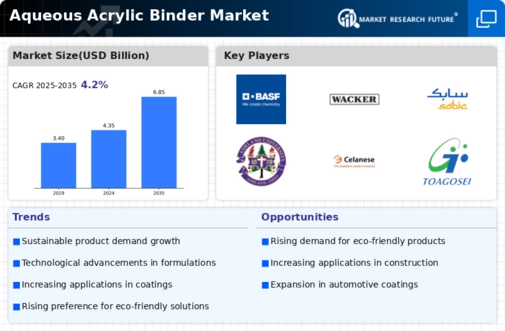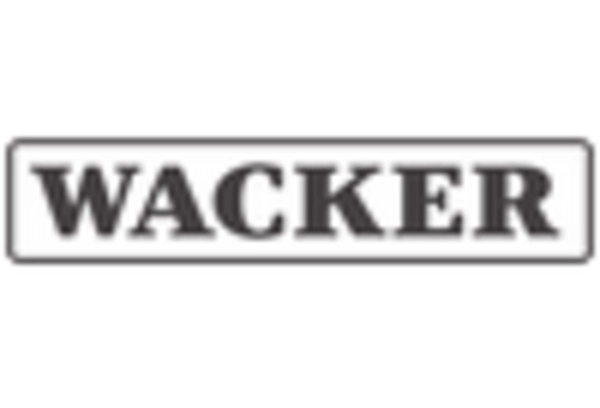Technological Innovations
Technological advancements play a crucial role in shaping the Aqueous Acrylic Binder Market. Innovations in formulation and production processes have led to the development of high-performance aqueous acrylic binders that meet diverse application needs. These advancements enhance the properties of binders, such as adhesion, flexibility, and resistance to weathering, making them suitable for a wide range of applications. Furthermore, the integration of smart technologies in manufacturing processes is streamlining production and improving efficiency. As a result, manufacturers are better positioned to respond to market demands and consumer preferences. The ongoing research and development efforts in this sector suggest a continuous evolution of product offerings, which could further stimulate market growth.
Sustainability Initiatives
The increasing emphasis on sustainability is a pivotal driver for the Aqueous Acrylic Binder Market. As industries strive to reduce their environmental footprint, the demand for eco-friendly materials has surged. Aqueous acrylic binders, known for their low volatile organic compound (VOC) emissions, align well with these sustainability goals. This shift is reflected in the growing preference for water-based coatings and adhesives, which are less harmful to both human health and the environment. According to recent data, the market for water-based coatings is projected to expand significantly, indicating a robust growth trajectory for aqueous acrylic binders. Companies are increasingly adopting these materials to meet regulatory standards and consumer expectations, thereby enhancing their market position.
Rising Demand in Construction
The construction sector is witnessing a notable increase in the adoption of aqueous acrylic binders, which serves as a key driver for the Aqueous Acrylic Binder Market. These binders are utilized in various applications, including paints, coatings, and sealants, due to their excellent adhesion properties and durability. The construction industry's growth, fueled by urbanization and infrastructure development, is expected to propel the demand for aqueous acrylic binders. Market data suggests that the construction sector's expansion could lead to a substantial increase in the consumption of these binders, as they are favored for their performance and environmental benefits. This trend indicates a promising outlook for manufacturers and suppliers within the aqueous acrylic binder landscape.
Growth in the Automotive Sector
The automotive industry is increasingly recognizing the benefits of aqueous acrylic binders, which serves as a significant driver for the Aqueous Acrylic Binder Market. These binders are utilized in various automotive applications, including coatings and adhesives, due to their superior performance characteristics. The shift towards lightweight materials and environmentally friendly solutions in automotive manufacturing is propelling the demand for aqueous acrylic binders. Market analysis indicates that the automotive sector's growth, driven by technological advancements and consumer preferences for sustainable products, is likely to enhance the consumption of these binders. This trend presents opportunities for manufacturers to innovate and expand their product lines to cater to the evolving needs of the automotive industry.
Increased Focus on Health and Safety
The heightened awareness regarding health and safety standards is emerging as a vital driver for the Aqueous Acrylic Binder Market. As industries prioritize worker safety and consumer health, the demand for low-toxicity materials is on the rise. Aqueous acrylic binders, characterized by their low VOC content, are increasingly preferred in applications where health and safety are paramount. This trend is particularly evident in sectors such as construction, automotive, and consumer goods, where regulatory compliance and consumer preferences are shaping material choices. Market data suggests that the shift towards safer alternatives is likely to drive the growth of aqueous acrylic binders, as manufacturers adapt their offerings to meet these evolving standards and expectations.


















Leave a Comment